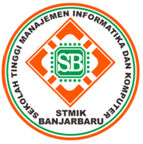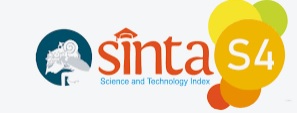Penerapan Aturan Asosiasi untuk Rule Mining pada Piala Dunia FIFA 2022
Abstract
Football strategy comes from learning and evaluation of previous matche, but there are only a few research that conducted to explore the synergies between players. This research was conducted to implement the data mining method; and association’s rule in the sports data case study. Football is already embracing new technology as part of its ecosystem. This research used a data mining method to explore and analyze the passing route of a football team in the biggest football tournament, FIFA World Cup 2022, held in Qatar. The data was collected from the Sports References website and preprocessed before being mined. An association rule is constructed using an apriori algorithm by creating the item sets, calculating the support and confidence value, and defining the rules. The results showed the formation of 3 association rules with a confidence limit of 95%. Rule mining using an apriori association provides the possibility of an antecedent and consequent combination, which is a combination of the order in which the ball moves from the first player to the third player until the occurrence of a goal.
Keywords: Association rule; Data mining; A priori algorithm; Soccer
Â
Abstrak
Pengembangan strategi sepak bola dilakukan dengan melakukan evaluasi dari pertandingan yang telah dilakukan sebelumnya, akan tetapi belum banyak penelitian yang dilakukan untuk melakukan evaluasi terhadap sinergi antar pemain pada suatu permainan. Penelitian ini dilakukan dengan tujuan untuk mengimplementasikan metode data mining pada bidang olahraga, salah satunya sepak bola, yang telah menggunakan teknologi sebagai bagian dari ekosistem permainan. Metode data mining digunakan untuk mengeksplorasi dan menganalisis operan pada tim sepak bola pada perhelatan turnamen Piala Dunia FIFA 2022 yang dilaksanakan di Qatar. Data yang dikumpulkan dari website Sport References dikenakan prapemrosesan data sebelum diolah. Penerapan aturan asosiasi dengan algoritme Apriori dilakukan dalam beberapa langkah, seperti pembentukan itemset, perhitungan nilai support dan confidence, hingga penentuan aturan atau rule. Hasil penelitian menunjukan pembentukan 3 aturan asosiasi dengan batasan confidence 95%. Rule mining menggunakan algoritme asosiasi Apriori memberikan kemungkinan kombinasi antecedent dan consequent yang merupakan kombinasi urutan perpindahan bola dari pemain pertama hingga pemain ketiga sampai dengan terjadinya goal.
Kata kunci: Aturan asosiasi; Data mining; Algoritme Apriori; Sepak bola
References
F. M. Clemente, F. M. L. Martins, D. Kalamaras, P. del Wong, and R. S. Mendes, “General network analysis of national soccer teams in FIFA World Cup 2014,†Int J Perform Anal Sport, vol. 15, no. 1, pp. 80–96, 2015, doi: 10.1080/24748668.2015.11868778.
H. Sarmento, F. M. Clemente, D. Araújo, K. Davids, A. McRobert, and A. Figueiredo, “What Performance Analysts Need to Know About Research Trends in Association Football (2012–2016): A Systematic Review,†Sports Medicine, vol. 48, no. 4, pp. 799–836, 2018, doi: 10.1007/s40279-017-0836-6.
F. M. Clemente, H. Sarmento, and R. Aquino, “Player position relationships with centrality in the passing network of world cup soccer teams: Win/loss match comparisons,†Chaos Solitons Fractals, vol. 133, p. 109625, 2020, doi: https://doi.org/10.1016/j.chaos.2020.109625.
F. M. Clemente, M. S. Couceiro, F. M. L. Martins, and R. S. Mendes, “Using Network Metrics in Soccer: A Macro-Analysis,†J Hum Kinet, vol. 45, no. 1, pp. 123–134, 2015, doi: 10.1515/hukin-2015-0013.
D. A. Syahruna and N. Nurhidayat, “Analisis Keterampilan Shooting dan Passing Pada Sekolah Sepak Bola Jurnal Porkes ( Jurnal Pendidikan Olahraga Kesehatan & Rekreasi ),†Jurnal Porkes, vol. 5, no. 2, pp. 706–716, 2022, doi: 10.29408/porkes.v5i2.
F. M. Clemente, F. M. L. Martins, P. del Wong, D. Kalamaras, and R. S. Mendes, “Midfielder as the prominent participant in the building attack: A network analysis of national teams in FIFA World Cup 2014,†Int J Perform Anal Sport, vol. 15, no. 2, pp. 704–722, 2015, doi: 10.1080/24748668.2015.11868825.
J. Duch, J. S. Waitzman, and L. A. Nunes Amaral, “Quantifying the performance of individual players in a team activity,†PLoS One, vol. 5, no. 6, pp. 1–7, 2010, doi: 10.1371/journal.pone.0010937.
G. Villa and S. Lozano, “Assessing the scoring efficiency of a football match,†Eur J Oper Res, vol. 255, no. 2, pp. 559–569, 2016, doi: https://doi.org/10.1016/j.ejor.2016.05.024.
B. Low, R. Rein, S. Schwab, and D. Memmert, “Defending in 4-4-2 or 5-3-2 formation? small differences in footballers’ collective tactical behaviours.,†J Sports Sci, vol. 40, no. 3, pp. 351–363, Feb. 2022, doi: 10.1080/02640414.2021.1993655.
B. Low, R. Rein, D. Raabe, S. Schwab, and D. Memmert, “The porous high-press? An experimental approach investigating tactical behaviours from two pressing strategies in football.,†J Sports Sci, vol. 39, no. 19, pp. 2199–2210, Oct. 2021, doi: 10.1080/02640414.2021.1925424.
G. J. Lee, J. J. Jung, and D. Camacho, “Exploiting weighted association rule mining for indicating synergic formation tactics in soccer teams,†Concurrency Computation , no. October 2020, pp. 1–14, 2021, doi: 10.1002/cpe.6221.
J. Spitz, J. Wagemans, D. Memmert, A. M. Williams, and W. F. Helsen, “Video assistant referees (VAR): The impact of technology on decision making in association football referees,†J Sports Sci, vol. 39, no. 2, pp. 147–153, Jan. 2021, doi: 10.1080/02640414.2020.1809163.
C. Shi and L. Liu, “Research on Physical Fitness Test Data Mining and Analysis Based on Apriori Algorithm,†in Journal of Physics: Conference Series, Oct. 2020, vol. 1634, no. 1. doi: 10.1088/1742-6596/1634/1/012175.
R. Zhu, J. Wang, F. Yu, and W. Wang, “Quality Evaluation of College Physical Training considering Apriori Algorithm,†Math Probl Eng, vol. 2022, p. 9057793, 2022, doi: 10.1155/2022/9057793.
B. G. Cook and J. E. Goff, “Parameter space for successful soccer kicks,†Eur J Phys, vol. 27, no. 4, p. 865, May 2006, doi: 10.1088/0143-0807/27/4/017.
L. Tianbiao and H. Andreas, “Apriori-based diagnostical analysis of passings in the football game,†in 2016 IEEE International Conference on Big Data Analysis (ICBDA), Mar. 2016, pp. 1–4. doi: 10.1109/ICBDA.2016.7509795.
S. R. LLC, “2022 World Cup Stats,†FBREF, 2022. https://fbref.com/en/comps/1/World-Cup-Stats
E. Brzychczy, “An overview of data mining and process mining applications in underground mining,†Inzynieria Mineralna, vol. 2019, no. 1, pp. 301–314, 2019, doi: 10.29227/IM-2019-01-52.
M. Kaushik, R. Sharma, S. A. Peious, M. Shahin, S. ben Yahia, and D. Draheim, “A Systematic Assessment of Numerical Association Rule Mining Methods,†SN Comput Sci, vol. 2, no. 5, pp. 1–13, 2021, doi: 10.1007/s42979-021-00725-2.
D. I. Purnamasari, A. Saefudin, V. A. Permadi, and R. P. Agusdin, “Consumer Behavior Analysis of Leathercraft Small and Medium-Sized Enterprises (SME) Using Market Basket Analysis and Clustering Algorithms,†An International Interdisciplinary Journal, vol. 24, no. 3, pp. 143–154, 2021.
A. Novianti and E. Elisa, “Penentuan Aturan Asosiasi Pola Pembelian Pada Minimarket Dengan Algoritme Apriori,†Building of Informatics, Technology and Science (BITS), vol. 2, no. 1, pp. 64–70, 2020, [Online]. Available: http://ejurnal.seminar-id.com/index.php/bits/article/view/300
How To Cite This :
Refbacks
- There are currently no refbacks.










